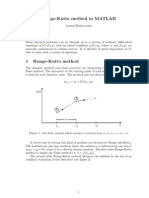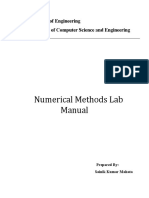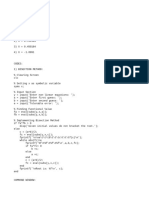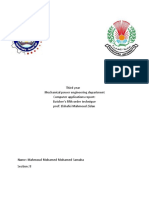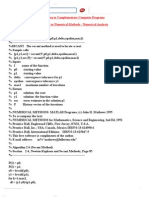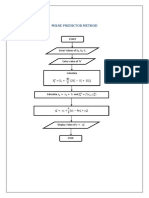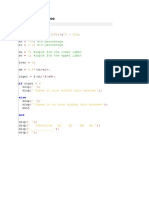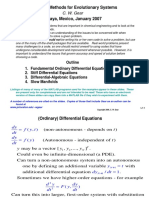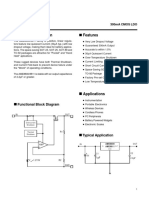MATLAB Lesson 5 Example 2: Newton-Raphson Method (Chapter 2)
- 2 x 5x 2 0. Use the Newton-Raphson
Numerical method in MATLAB
( 10 4 )
Example 1: Trapezoidal rule (Chapter 1, Slide 31)
clc, clearvars
% define variables
% define function of f(x)
f = @(x) 2^x-5*x+2;
% define function of f'(x)
df = @(x) log(2)*2^x - 5;
% define error
e = 10^-4;
% define initial values
x0 = 0;
% define number of iterations
n = 10;
clc, clearvars; % processing
if df(x0)~=0
% define function for i=1:n
f=@(x) 0.2+25*x-200*x^2+675*x^3-900*x^4+400*x^5; x1 = x0 - f(x0)/df(x0)
% lower limit of integral x0 = x1;
a=0; end
% upper limit of integral else
b=0.8; disp("failed")
% number of segment end
n=2;
% step
h=(b-a)/n;
% define an empty variable to store the value
sum=0.0;
for i=1:n-1
x=a+i*h;
sum=sum+f(x);
end
answer=h*(f(a)+2*sum+f(b))/2.0;
fprintf('Evaluated Integral =%f',answer);
�clc, clearvars
% define variables
% define function of f(x)
f = @(x) 2^x-5*x+2;
% define function of f'(x)
df = @(x) log(2)*2^x - 5;
% define error
e = 10^-4;
% define initial values
x0 = 0;
% define a number of iterations
n = 10;
% processing
if df(x0)~=0
for i=1:n
x1 = x0 - f(x0)/df(x0)
if abs(x1-x0)<e
break
end
x0 = x1;
end
else
disp("failed")
end
� : (Chapter 2)
clc, clearvars
% define variables Consider the ln 2 with a third-order
% define function of f(x)
f = @(x) 2^x-5*x+2; Newton’s ,
% define function of f'(x)
df = @(x) log(2)*2^x - 5;
% define error
e = 10^-4;
x1 1; f ( x1 ) 0
% define initial values x2 4; f ( x2 ) 1.386294
x0 = 0;
% define a number of iterations x3 6; f ( x3 ) 1.791759
n = 10;
% processing x4 5; f ( x4 ) 1.609438
if df(x0)~=0
for i=1:n
x1 = x0 - f(x0)/df(x0);
fprintf('x%d = %0.20f\n', i ,x1)
clc, clearvars
if abs(x1-x0)<e
break
% Create vectors with the known data
end
%I changed the order of x3,y3 and x4,y4 so the points are increasing
x0 = x1;
x=[1,4,5,6]; %known x values
end
y=[0,1.386294,1.609438, 1.791759]; %known y values
else
b1=y(1);
disp("failed")
b2=(y(2)-y(1))/(x(2)-x(1));
end
b3=0; %edit this
b4=0; %edit this
b5=0; %edit this
xq=2; %query point
yq=b1+b2*(xq-x(1)); %edit this
fprintf('y(interp)=%.4f at x=%.4f.\n',yq,xq);
�Example 3: Euler’s method (Chapter 3) Example : Heun’s method (Chapter 3)
dy dy
2 x 3 12 x 2 20 x 8.5 x 0 to x 4 Use Heun 1 y2 x 0 to 0.4
dx dx
with a x 0 is y 1. 2 x 0 is y 0. (Tutorial 3 Q1 part (ii))
clc, clearvars; clc, clearvars
% define step size t0 = 0; % initial time
h=0.5; tn = 0.4; % final time
% the range of x n = 2; % number of steps
x=0:h:4; y0 = 0; % initial value
% allocate the result y
y=zeros(size(x)); h = (tn - t0) / n; % step size
% the initial y value when x = 0, y = 1 t = t0 : h : tn; % equally spaced base points
y(1)=1; y = zeros(size(t)); % approximate solutions
% the number of y values
n=numel(y); f = @(t, y) 1 + y^2; % increment function
% The FOR loop to solve the DE
for i = 1:n-1 % Heun's method
dydx= -2*x(i).^3 +12*x(i).^2 -20*x(i)+8.5 ; y(1) = y0; % initial condition
y(i+1) = y(i)+dydx*h ; for i = 1 : n
fprintf('y%d = %0.5f\n', i ,y(i)) k1 = f(t(i), y(i));
end k2 = f(t(i) + h, y(i) + k1 * h);
y(i + 1) = y(i) + (0.5 * k1 + 0.5 * k2) * h;
fprintf('y%d = %0.5f\n', i ,y(i))
end
disp([t' y'])
�Example 5: - ’s method (Chapter
3)
dy
Use - ’s 1 y2 x 0 to 0.4
dx
x 0 is y 0. (Tutorial 3 Q1 part (iii))
clc, clearvars
t0 = 0; % initial time
tn = 0.4; % final time
n = 2; % number of steps
y0 = 0; % initial value
h = (tn - t0) / n; % step size
t = t0 : h : tn; % equally spaced base points
y = zeros(size(t)); % approximate solutions
f = @(t, y) 1 + y^2; % increment function
% Runge-Kutta 4th order method
y(1) = y0; % initial condition
for i = 1 : n
k1 = f(t(i), y(i));
k2 = f(t(i)+0.5*h,y(i)+0.5*h*k1);
k3 = f((t(i)+0.5*h),(y(i)+0.5*h*k2));
k4 = f((t(i)+h),(y(i)+k3*h));
y(i + 1) = y(i) + (1/6)*(k1+2*k2+2*k3+k4)*h;
fprintf('y%d = %0.5f\n', i ,y(i))
end
disp([t' y'])











